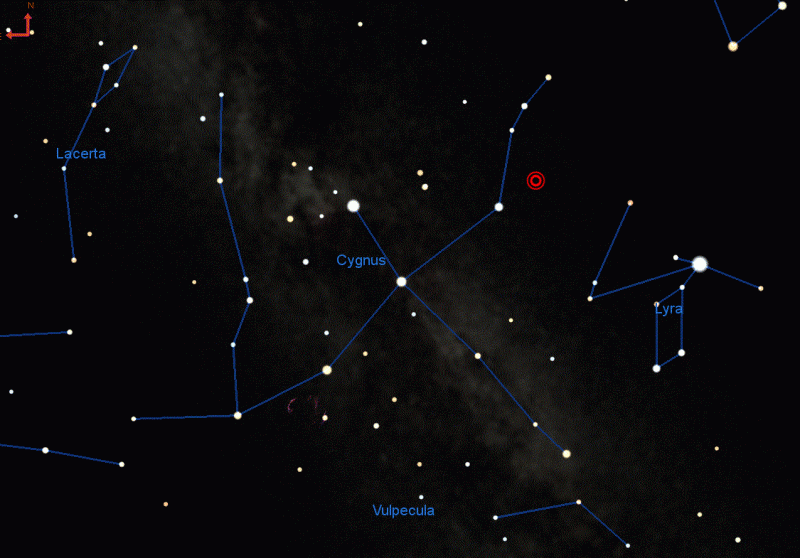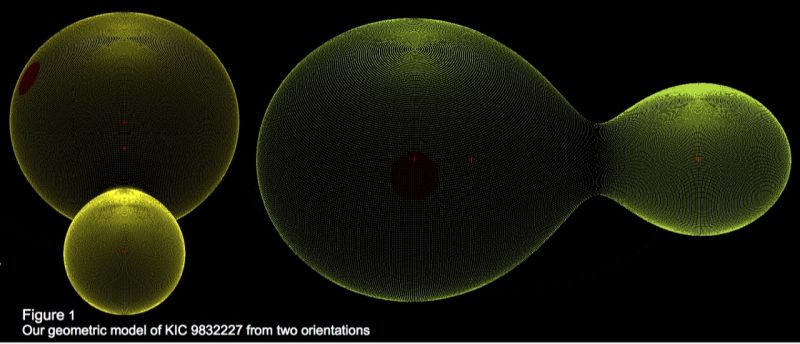Astronomer Larry Molnar and his colleagues and students have made an unprecedented prediction of a star explosion – due in the year 2022, or thereabouts, they say – that’ll become visible from Earth, even to those without telescopes. The star system is an eclipsing binary system (one star passes in front of the other as seen from Earth) called known as KIC 9832227. New evidence suggests that these two very close stars are getting closer and will merge explosively, soon. Molnar is presenting his findings today (January 6, 2017) at the 229th meeting of the American Astronomical Society in Texas.
He said the prediction, originally made in 2015, of the merging of the two stars in the KIC 9832227 system is “progressing from theory to reality” and he added:
It’s a one-in-a-million chance that you can predict an explosion. It’s never been done before.
Molnar and colleagues’ prediction is that the two stars in the KIC 9832227 system will get closer and closer and finally merge and explode in 2022, give or take a year. When that happens, he says, the star will increase its brightness 10 thousandfold, temporarily becoming a bright star in Earth’s sky.
The star will be visible as part of the constellation Cygnus, and will add a star to the recognizable Northern Cross star pattern.


Molnar’s exploration into the KIC 9832227 system began in 2013. He was attending an astronomy conference when fellow astronomer Karen Kinemuchi presented her study of the brightness changes of the star, which concluded with a question: Is it pulsing or is it a binary?
Also present at the conference was then Calvin College student Daniel Van Noord, Molnar’s research assistant at the time. Van Noord took the question as a personal challenge and made some observations of the star with the Calvin observatory. Molnar said:
He looked at how the color of the star correlated with brightness and determined it was definitely a binary. In fact, he discovered it was actually a contact binary, in which the two stars share a common atmosphere, like two peanuts sharing a single shell.
From there Dan determined a precise orbital period from Kinemuchi’s Kepler satellite data (just under 11 hours) and was surprised to discover that the period was slightly less than that shown by earlier data.

According to Molnar, this result brought to mind work published by astronomer Romuald Tylenda, who had studied the observational archives to see how another star (V1309 Scorpii) had behaved before it exploded unexpectedly in 2008 and produced a red nova (a type of stellar explosion only recently recognized as distinct from other types). The pre-explosion record showed a contact binary with an orbital period decreasing at an accelerating rate.
For Molnar, this pattern of orbital change was a “Rosetta stone” for interpreting the new data.
In the past two years, Molnar and his team have been performing observational tests, which ruled out alternate explanations and strengthened their belief that KIC 9832227 will soon explode. Molnar said:
Bottom line is we really think our merging star hypothesis should be taken seriously right now and we should be using the next few years to study this intensely so that if it does blow up we will know what led to that explosion.
To that end, Molnar and colleagues will be observing KIC 9832227 in the next year over the full range of wavelengths: using the Very Large Array, the Infrared Telescope Facility, and the XMM-Newton spacecraft to study the star’s radio, infrared and X-ray emission, respectively.
Molnar says that this is the beginning of a story that will unfold over the next several years, and people of all levels can participate:
The orbital timing can be checked by amateur astronomers … They can measure the brightness variations with time of this 12th-magnitude star as it eclipses and see for themselves if it is continuing on the schedule we are predicting or not.
Bottom line: Astronomer Larry Molnar and colleagues are predicted that the two stars in the KIC 9832227 binary system will merge and explode around the year 2022. If it happens, the system will increase in brightness 10 thousandfold, temporarily becoming a bright star in Earth’s sky.











